Hello! This article will be short, but that doesn't make it any less useful. Today we will search for you. What? The place where they are stored backups iPhone. What for? For example, to transfer files and save them on a flash drive (it will be very useful when reinstall windows). Or, in order to save space on your hard drive. After all, outdated data is often not needed, but precious megabytes, but what's there - they take up gigabytes. Why so much? Because the full image of your device is stored, including almost everything!
For example: photos, calendars, voice recorder, notes, contacts, messages, program data, bookmarks, clips, wallpapers, wireless data Wi-Fi connections, Bluetooth…. etc.
Important note: everything that is written above and below will be useful not only to the owners of the best phone from Apple, but also to owners of no less excellent iPad tablet and a cool iPod music player.
As we know, you can create a backup of information using either , or . So here is the place Where is the backup stored? replica iPhone , for each of these methods is different.
Let's start with the "clouds" iCloud.
AT this case, Your data is stored on Apple's servers. However, I want to remind you that the size free storage is only 5 gigabytes. For larger quantities, you need to pay extra. Therefore, if you had several gadgets from the apple company, and now you are using one, I recommend deleting the old, unnecessary “device information”. To find them, go to settings, select iCloud:
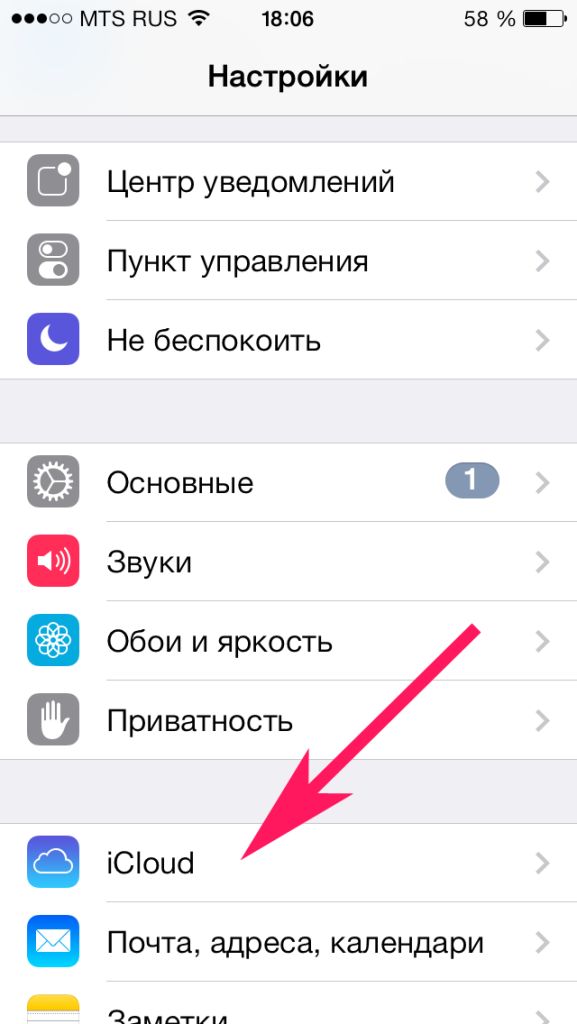
Scroll down - the item "storage and ....", on the next screen, click on the storage.


Here they are! :) You can see detailed information: volume, creation date, which applications and how much space they occupy. And then delete the iPhone backup.

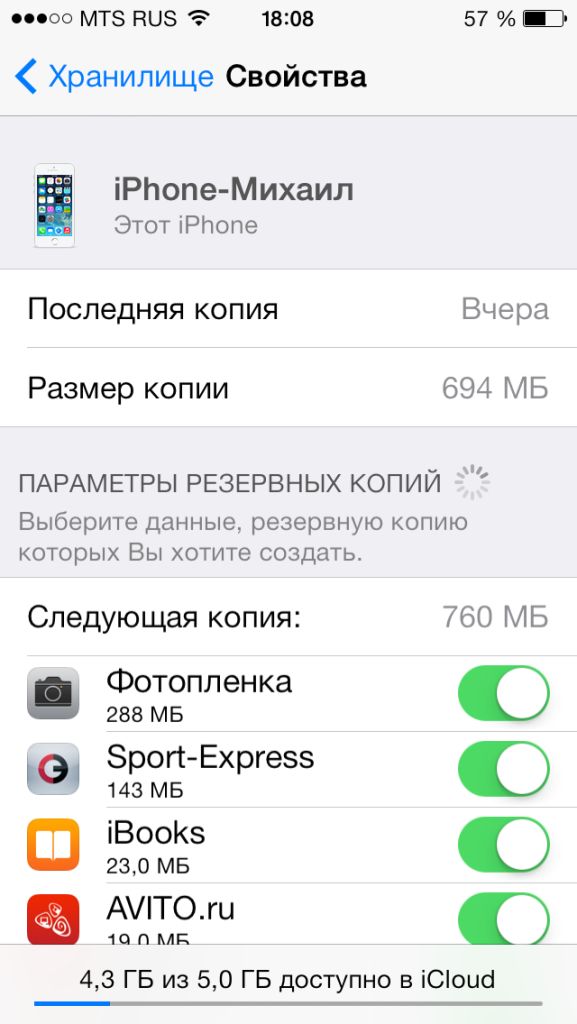
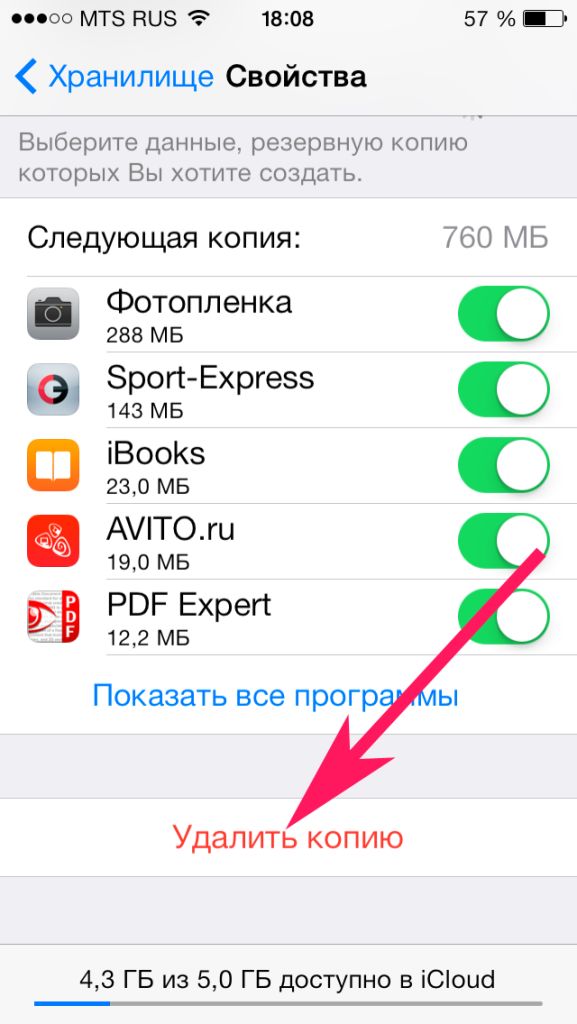
True, you can't copy it anywhere. But this is not necessary, because you can always access it thanks to Apple ID (what is it read) and account iCloud. Updated! You can download and view data from the "clouds"! How? Reading!
Backup iPhone to Computer created with using iTunes- can be in different places, it all depends on the operating system which is being used. Below is a small figure with their location for various Windows versions, as well as for Mac Os.

If suddenly you did not find these folders, then turn on "show hidden files" in the settings (relevant for owners of computers with Windows).
As promised, the instructions turned out to be short. But the goal, I think, has been achieved. Now you know where your iPhone backups are. That will allow you to manage them at your own discretion - delete, transfer, copy.
P.S. Did you not understand something or have any questions? Feel free to ask them in the comments - I will definitely try to suggest and answer absolutely everyone! Write!
P.S.S. Like and click buttons social networks located below the article! What for? It’s just that it’s not difficult for you to do this, but the author will be pleased :)
I made a backup copy of my iphone on one computer, and I need to transfer it to another. What to do? how to transfer on Windows?
Before iPhone users, sooner or later, the question arises of where backups are stored. And it will be better if you find out about this in advance than when, after reinstalling the OS, all your contacts, photos and notes disappear. Information on an iPhone can cost more even than the device itself. Therefore, it is worth taking seriously the topic under discussion.
iPhone sync and backups
In order to protect yourself from data loss, you need to make a backup copy of your iPhone before starting synchronization.
It includes:
- address book (all contacts) and call history;
- calendars, reminders, notes, messages (iMessage, SMS, and MMS);
- photos taken by this device (downloaded from other media are not included here);
- data various programs(this includes game walkthroughs, documents,
- films in programs third party developers(not converted for iPhone);
- Safari browser data.
A backup copy is created in order to save data in the event of:
- phone breakdown;
- accidental deletion of data;
- software failure;
- cloud service failure.
Choose a copy location
There are two possible options for saving an iPhone backup. You can store it:
- using iTunes (using a computer);
- via iCloud (in the cloud, on Apple servers).
You have to choose one. A copy can be stored in one of these places, there is no way to duplicate them.
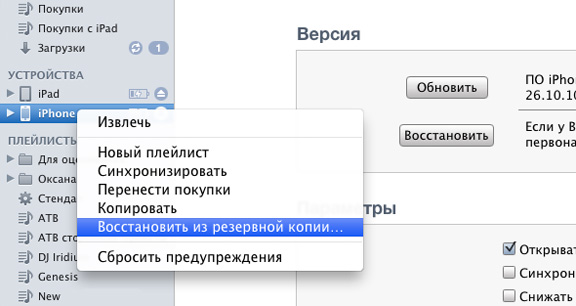
This process in new and old iTunes will be different.
In older iTunes, you need to do the following steps:
- connect the device to the computer;
- find it in the column on the left, where the selection of sections is located;
- in the device window that opens, go down to the item “ Backup»;
- decide on the choice of the copy execution path (iCloud, or a classic copy on a computer);
- wait for the copy process to complete.

In iTunes 11, this process is automated, but if you suddenly turned off this feature, then you need to do some manipulations.
AT new iTunes(version 11) you need:
- connect the device to the computer;
- find a device based on its name;
- Start Backup by clicking on Back Up Now.

Where to store copies on your computer
The storage paths will depend on your computer's operating system.
For Windows XP it looks like this:
Documents and Settings\Username\Application Data\Apple Computer\MobileSync\Backup\.
For Vista or Windows 7:
Users\Username\AppData\Roaming\Apple Computer\MobileSync\Backup\.
For Mac OS: \Users\Username\Libraries\Application Support\MobileSync\Backup.
The item "Username" must be changed to the name that suits you. Owners of computers on Mac OS may have problems finding the Libraries folder. It has been hidden since version 10.7 (Lion). To get into it, you need to own command line or:
- Open Finder and click on the "Transition" tab at the top.
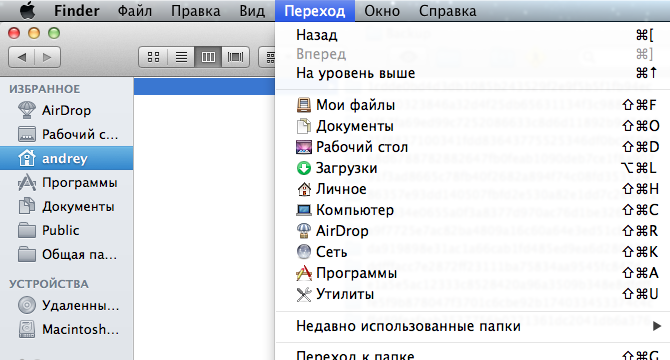
- when you press the Alt key, the "Libraries" folder will appear in the menu, you need to go to it.
- further actions follow the instructions above.
Other backup locations
In addition to the places described above, copies can be found in iTunes and cloud service. A significant disadvantage of these places is limited functionality. The backup copy can only be deleted, no other manipulations with it are possible. You need to find it in iTunes by opening the program itself and going to the settings. 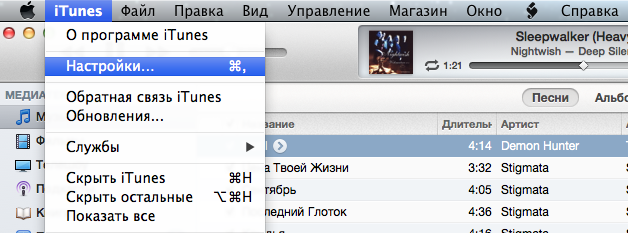 In the window that opens, go to the "Devices" tab
In the window that opens, go to the "Devices" tab 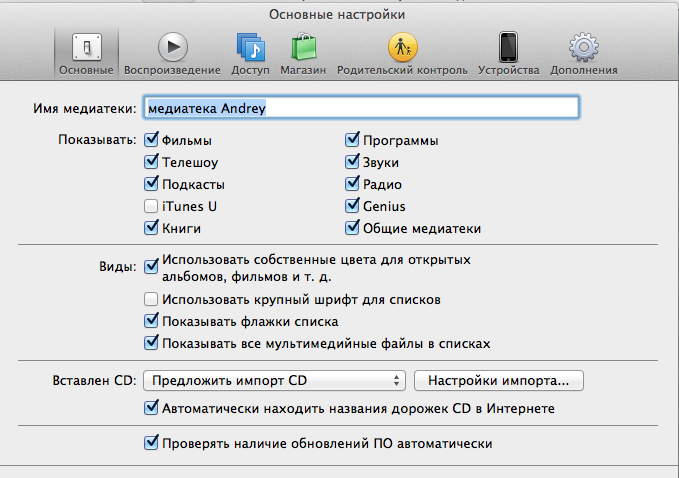 The window shows all the backups available on the computer and the date they were created.
The window shows all the backups available on the computer and the date they were created. 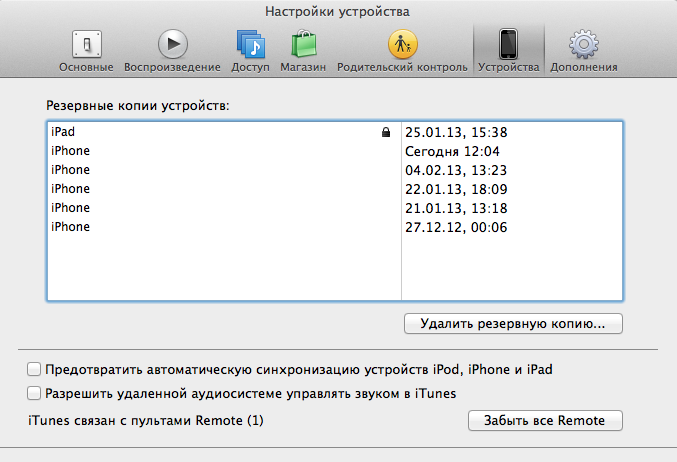 You can remove them. Other actions are not available. You will not be able to copy or transfer them in this way.
You can remove them. Other actions are not available. You will not be able to copy or transfer them in this way.
Another place to store cloud service Apple iCloud. From the moment you enable backup, this process will happen automatically every day. For this, three conditions must be met:
- Internet connections;
- connection to a power source;
- screen lock.
The function to restore data from a backup is available during the first start of the phone. He always asks about it, and can do it after entering his login and password.
How to restore iphone backup
The sync process creates a backup on iPhone. It can later be used to restore content. Data can be easily transferred to different devices. Encrypted backups (in iOS 4) migrate passwords along with the copy to new hardware.
Whatever experiments you do with your iPhone, remember that before any interference with it, you need to make a backup. This function will help to save all the necessary information in case of a phone change, or a mistake is made when taking steps to improve it.
Before iPhone users, sooner or later, the question arises of where backups are stored. And it will be better if you find out about this in advance than when, after reinstalling the OS, all your contacts, photos and notes disappear. Information on an iPhone can cost more even than the device itself. Therefore, it is worth taking seriously the topic under discussion.
In order to protect yourself from data loss, you need to make a backup copy of your iPhone before starting synchronization.
It includes:
- address book (all contacts) and call history;
- calendars, reminders, notes, messages (iMessage, SMS, and MMS);
- photos taken by this device (downloaded from other media are not included here);
- data from various programs (this includes passing games, documents,
- movies in third-party software (non-converted for iPhone);
- Safari browser data.
A backup copy is created in order to save data in the event of:
- phone breakdown;
- accidental deletion of data;
- software failure;
- cloud service failure.
Choose a copy location
There are two possible options for saving an iPhone backup. You can store it:
- using iTunes (using a computer);
- via iCloud (in the cloud, on Apple servers).
You have to choose one. A copy can be stored in one of these places, there is no way to duplicate them.

This process will be different in new and old iTunes.
In older iTunes, you need to do the following steps:
- connect the device to the computer;
- find it in the column on the left, where the selection of sections is located;
- in the device window that opens, go down to the "Backup" item;
- decide on the choice of the copy execution path (iCloud, or a classic copy on a computer);
- wait for the copy process to complete.

In iTunes 11, this process is automated, but if you suddenly turned off this feature, then you need to do some manipulations.
In the new iTunes (version 11) you need:
- connect the device to the computer;
- find a device based on its name;
- Start Backup by clicking on Back Up Now.

Where to store copies on your computer
The storage paths will depend on your computer's operating system.
For Windows XP it looks like this:
Documents and Settings\Username\Application Data\Apple Computer\MobileSync\Backup\.
For Vista or Windows 7:
Users\Username\AppData\Roaming\Apple Computer\MobileSync\Backup\.
For Mac OS: \Users\Username\Libraries\Application Support\MobileSync\Backup.
The item "Username" must be changed to the name that suits you. Owners of computers on Mac OS may have problems finding the Libraries folder. It has been hidden since version 10.7 (Lion). To get into it, you need to own the command line or:
- Open Finder and click on the "Transition" tab at the top.

- when you press the Alt key, the "Libraries" folder will appear in the menu, you need to go to it.
- further actions follow the instructions above.
Other backup locations
In addition to the places described above, copies can be found in iTunes and the cloud service. A significant disadvantage of these places is limited functionality. The backup copy can only be deleted, no other manipulations with it are possible. You need to find it in iTunes by opening the program itself and going to the settings.  In the window that opens, go to the "Devices" tab
In the window that opens, go to the "Devices" tab  The window shows all the backups available on the computer and the date they were created.
The window shows all the backups available on the computer and the date they were created.  You can remove them. Other actions are not available. You will not be able to copy or transfer them in this way.
You can remove them. Other actions are not available. You will not be able to copy or transfer them in this way.
Another storage place is Apple's cloud service - iCloud. From the moment you enable backup, this process will happen automatically every day. For this, three conditions must be met:
- Internet connections;
- connection to a power source;
- screen lock.
The function to restore data from a backup is available during the first start of the phone. He always asks about it, and can do it after entering his login and password.
How to restore iphone backup
The sync process creates a backup on iPhone. It can later be used to restore content. Data can be easily transferred to different devices. Encrypted backups (in iOS 4) migrate passwords along with the copy to new hardware.
Whatever experiments you do with your iPhone, remember that before any interference with it, you need to make a backup. This function will help to save all the necessary information in case of a phone change, or a mistake is made when taking steps to improve it.
iTunes is a must-have companion for any owner of an iOS device. The utility helps not only to exchange content between a PC and mobile device, but also makes it possible to update or restore an "apple" gadget, buy and download new applications and media files, create a ringtone, etc. However, perhaps the most important option of the program is to perform a backup, because today we store so much important and valuable information in our mobile assistants that it will be extremely pitiful to lose it if it is lost / stolen or simply when the device breaks down.
This article will explain how to back up data in iTunes and where iTunes stores backups.
Creating a backup in iTunes is a very simple procedure and even a novice user can handle it. To perform a backup, follow these instructions:
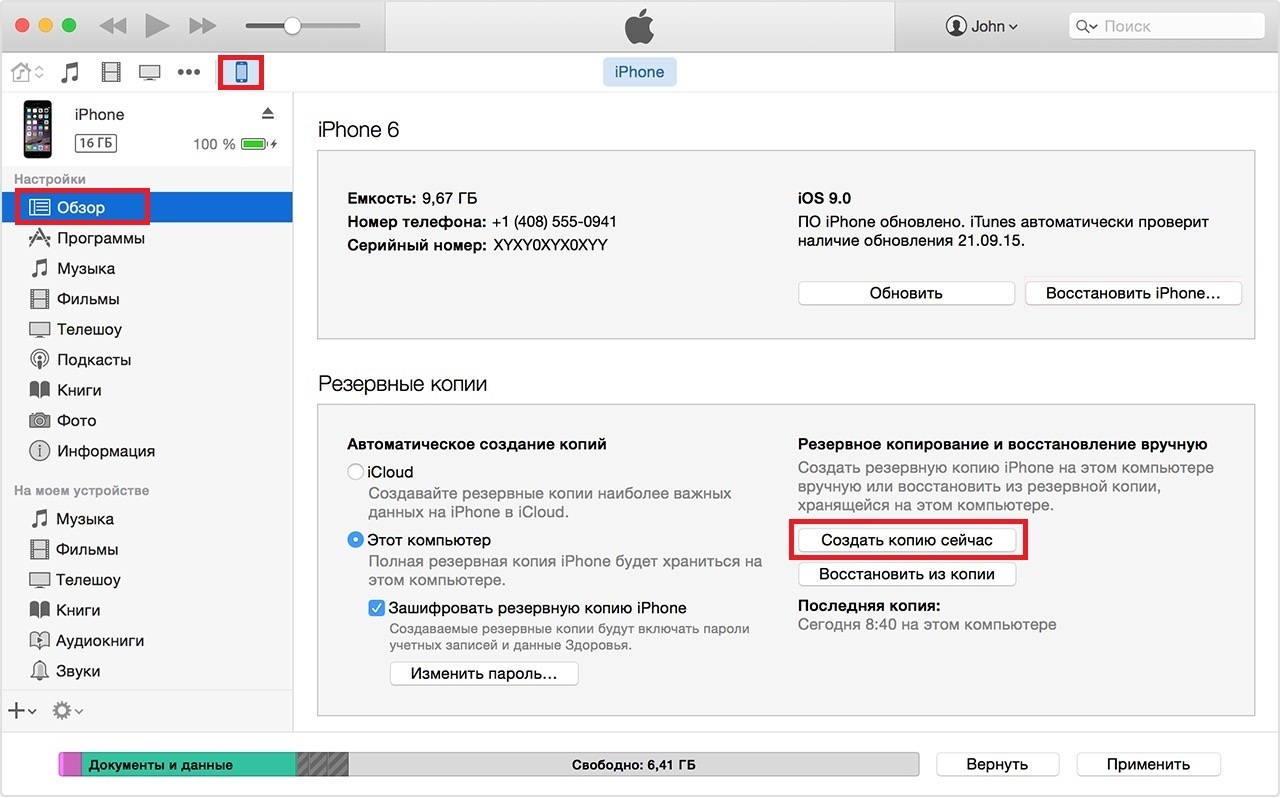
Ready! It remains only to wait until the program saves the created duplicate on the PC. You can verify that the iTunes backup was successful by opening the "Edit" section of the program, then "Settings" and going to the "Devices" tab - the generated copy and the number of its creation will be displayed here.
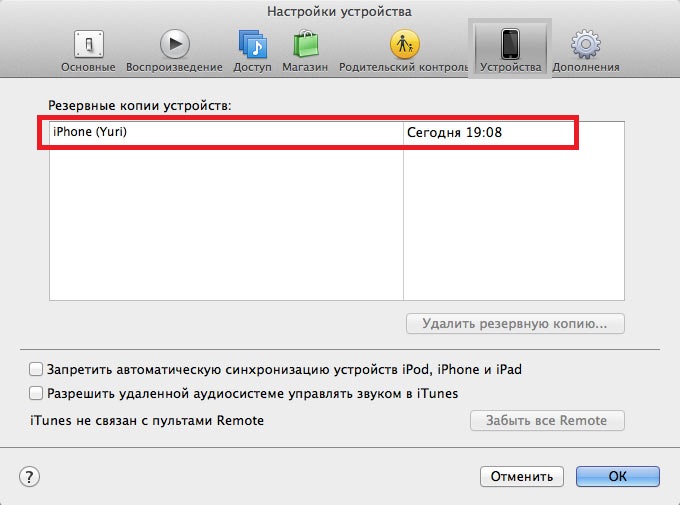
As you understand, the backup needs to be repeated regularly. At the same time, please note that only the last up-to-date duplicate will be stored on the computer - when creating a new backup, deletion of old data is performed automatically.
Where are iTunes backup files stored?
So, we figured out how to make a backup copy, but you probably have a logical question - where exactly does the program save the backed up information and whether it can be viewed. Well, let's figure it out.
The directory in which the utility locates the copied instance of data depends on which PC you are working with.
If you own a Mac, the storage location can be accessed as follows:
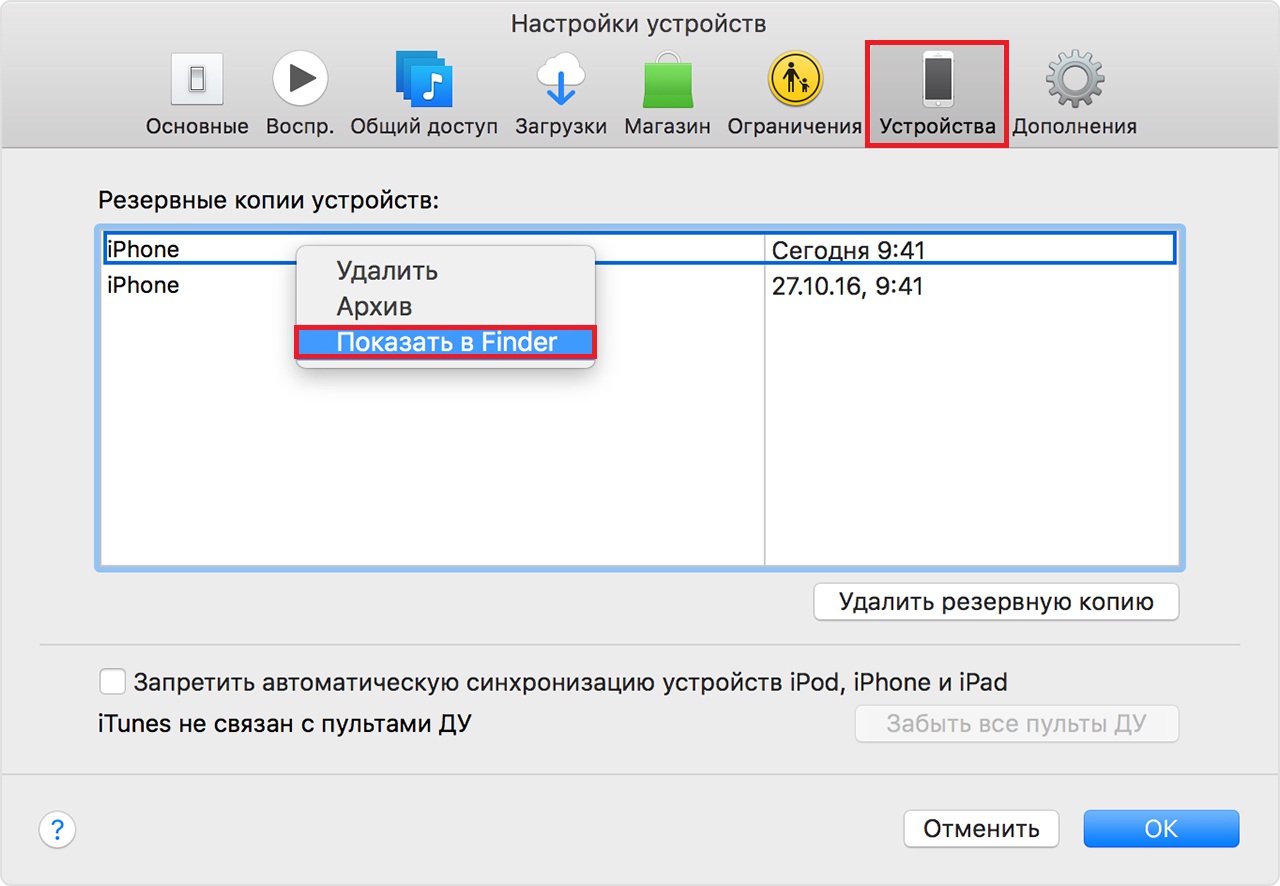
In the event that you are using a Windows computer to find the storage location of the backed up information:

How to view files and restore from an iTunes backup?
Now about how the backup saved in iTunes looks like. It is a folder whose name contains 40 characters. This folder hides a bunch of other folders. None of the folders can be renamed, also on the official page Apple support It is strongly not recommended to transfer the folder with the backup information anywhere. After all, something can be inadvertently damaged - accidentally delete some important file, and if the duplicate is corrupted, when restoring data, you will most likely encounter an error.

However, most likely, when you see this pile of folders, you will have a question not how to transfer them somewhere, but how to restore any information from a copy that looks so strange. Well, that is, everything is clear with iCloud - if you made a backup in the cloud, you just open the iCloud.com website, log in using your Apple ID and see all the backed up data, neatly arranged into understandable sections - "Contacts", "Photo" etc.
With iTunes, everything is somewhat different - you can’t see the data here, but, in fact, this should not worry the user too much. After all, this will not prevent data from being restored from iTunes to new iOS device. When transferring content, the user will be required to initial setup new gadget, just select the "Restore via iTunes" item and connect the device to the PC - all work will be done automatically.
But what if you need to partially extract the backed up content in order to later transfer it, for example, to an Android device. This is where you have to sweat. Each type of information has its own mechanisms. For example, how to copy contacts, you can see.
By the way, a complete list of information stored by duplicate data in iTunes can be found in this article.
What to do if iTunes backups refuse to be created?
Unfortunately, sometimes when performing a backup, you may come across an error: "iTunes was unable to create a backup." There can be many reasons for it - from the banal wear of the synchronization cable to conflicts with virus software.
First of all, if the backup procedure fails, it is recommended to take the following measures to eliminate the error:
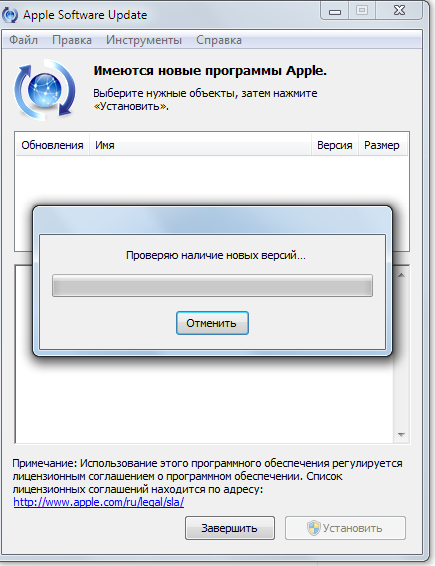
If none of the recommendations help and you still can't backup, read this article or contact Apple Support.
Let's summarize
Well, now you know how to duplicate data in iTunes, and you also know where the program stores folders with copies made. Unfortunately, it is impossible to view the information in them directly, but this is not important for restoring content. If you made a backup through iTunes, you can always pull information out of the copy using special programs and get it in the end in the proper form.
How to back up iPhone, iPad, iPod Touch
How to Change iTunes Backup Folder!
How to back up an iPhone or iPad
iPhone Backup
How to Pull Contacts from an iPhone Backup (iTunes)
Deleting backups from iTunes
Delete device backups from iTunes
Every time you sync between your Apple device and iTunes, this media processor creates a fresh backup. This very useful feature The program can be of great help if for some reason you have lost all the information from your Iphone. And iTunes in just two clicks will help you return all the information to its place. However, if you do, for example, reinstall Windows on your computer, then you can easily lose the backup. In this case, you should also play it safe by copying the backup data to removable media or any cloud service. Therefore, today you will find out where the iTunes backup is stored on your computer.
Backup location on Mac OS X.
In order to access the backup files, you need to go to: ~//Libraries/Application Support/MobileSync/Backup/. Now copy the Backup folder and save it in a safe place.
Backup location on Windows XP.
Backup on a computer running under Windows control XP is located at the following address: \Documents and Settings\(username)\Application Data\Apple Computer\MobileSync\Backup\.
Backup location on Windows 7/8.
To access backup data on Windows 7/8, open Windows Explorer and navigate to: C:\Users\(username)\AppData\Roaming\Apple Computer\MobileSync\Backup\.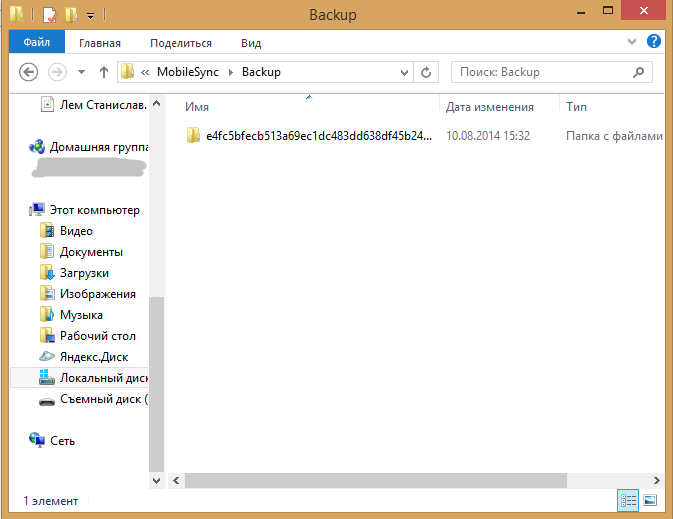
Pay special attention to the fact that the data in this folder may not be displayed, because. they are hidden. To see the files contained in the Backup folder, open the Start menu and select Control Panel. In Windows 8, move your mouse cursor to the very right side of the screen to open the navigation bar and select the Settings button. In the "Parameters" is the section "Control Panel" we need. Opening the "Control Panel", go to the item "Folder Options". A window will open in which you need to go to the "View" tab and activate the "Show hidden files, folders and drives. Then click "Apply" and the "OK" button. 
It is also worth noting that only one backup copy is required for each Apple device. With each new synchronization of the device with iTunes, the old backup will be replaced with a more recent one, i.e. all previous data will be hopelessly lost. You can safely save a backup copy in any cloud storage, for example,
